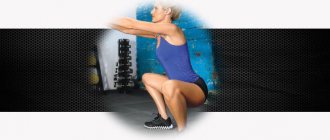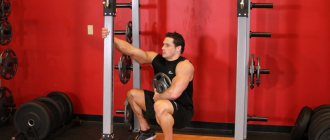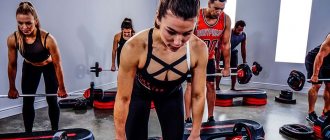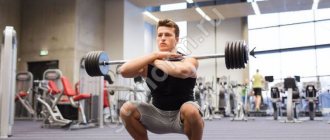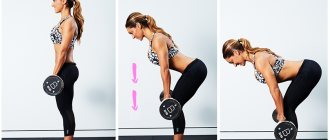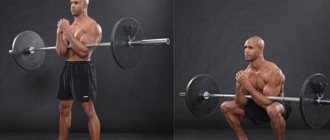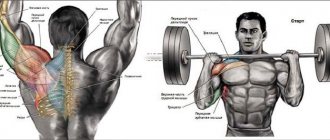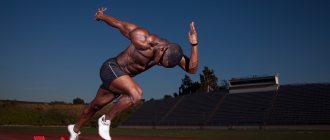Squats with a barbell on the shoulders are deservedly one of the three most powerful developing basic exercises. During squats, the main muscle groups of the legs and back are included in the work. The exercise is complex, multi-joint.
Different sports allow different squat depths. In weightlifting, athletes sit as deep as possible, almost until their buttocks touch the floor.
In powerlifting, the permissible squat depth is when the thighs are parallel to the floor.
Consider this type of squats.
Powerlifting is a sport in which squats with the heaviest weights. To ensure that the athlete is not crushed at the bottom of the squat and to ensure the safety of the knees, the test depth of the squat should be up to parallel or several degrees below parallel.
To maximize the load on the lower back, powerlifters squat with their legs wide apart. The second name for this squat is the sumo squat.
What muscles are involved in the exercise?
The main load is taken by the muscles of the legs and back. With a wide stance, the emphasis shifts from the quadriceps to the inner thighs.
Main muscles:
- Posterior thigh
- Adductor muscles of the thigh
- Gluteus maximus muscle
- Quadriceps
Stabilizing muscles:
- Lumbosacral muscle
- Abdominal muscles
- Trapezius muscles
The strong tension of the adductor muscles of the thigh serves as a certain limiter, preventing the athlete from falling into a deep squat.
Execution technique
Initial position
The bar is located on racks or in a power frame. The bar is located just below shoulder height so that you can sit down and remove the bar from the racks.
- Walk up to the barbell and grab it with your hands. The grip width is as close as possible to shoulder width. The narrower the grip, the stronger the retraction of the shoulder blades and the better the tension in the back is maintained throughout the movement.
- Dive under the barbell and place the bar on your shoulders. There is a hollow in the back surface of the trapezius muscles where the bar fits comfortably. In competitive powerlifting, they try to place the bar as low on the back as possible. This position lowers the center of gravity, reduces the load on the lower back and allows you to squat with more weight.
- Straighten your legs, remove the bar from the racks and take a step back.
- Place your feet wider than shoulder-width apart. The toes are turned outward at an angle of 45 degrees. The knees are directed towards the feet. Body weight on heels.
- Retract your shoulder blades. Pull your elbows back. Arch your lower back. Look forward and slightly up.
Basic movement
- As you inhale, move your pelvis back and begin the downward movement by bending your legs.
- Lower yourself until the angle of your knee joints reaches 90 degrees. Imagine that you are sitting on a chair (toilet).
- As you exhale, straighten your legs and move your pelvis forward. The upward movement begins with the shoulders, then the legs are included. When setting your legs wide, it is not recommended to fully straighten your knees.
Once you have completed the required number of squats, step forward and place the barbell on the rack.
IPA federation category standards for barbell squats 2012
Tags: Standards, Discharges, Squats
1. IPA grade standards for equipped barbell squats.
2. IPA rank standards for barbell squats without equipment.
3. IPA-A category standards for squats with a barbell in equipment.
4. IPA-A category standards for squats with a barbell without equipment.
IPA Federation. Discharges for squats with a barbell in equipment.
Table 1. Men.
| 52 | 245.0 | 215.0 | 190.0 | 167.5 | 150.0 | 132.5 | 117.5 |
| 56 | 267.5 | 232.5 | 207.5 | 182.5 | 162.5 | 142.5 | 127.5 |
| 60 | 287.5 | 250.0 | 222.5 | 197.5 | 175.0 | 155.0 | 135.0 |
| 67.5 | 320.0 | 280.0 | 250.0 | 220.0 | 195.0 | 172.5 | 152.5 |
| 75 | 350.0 | 305.0 | 272.5 | 240.0 | 212.5 | 187.5 | 165.0 |
| 82.5 | 372.5 | 325.0 | 290.0 | 257.5 | 227.5 | 200.0 | 177.5 |
| 90 | 395.0 | 345.0 | 307.5 | 270.0 | 240.0 | 212.5 | 187.5 |
| 100 | 415.0 | 362.5 | 325.0 | 285.0 | 252.5 | 225.0 | 197.5 |
| 110 | 432.5 | 380.0 | 337.5 | 297.5 | 265.0 | 232.5 | 207.5 |
| 125 | 455.0 | 397.5 | 355.0 | 312.5 | 275.0 | 245.0 | 215.0 |
| 140 | 470.0 | 412.5 | 365.0 | 322.5 | 285.0 | 252.5 | 222.5 |
| 140+ | 480.0 | 422.5 | 377.5 | 332.5 | 295.0 | 260.0 | 230.0 |
up
Table 2. Women.
| 44 | 155.0 | 140.0 | 125.0 | 110.0 | 97.5 | 85.0 | 75.0 |
| 48 | 172.5 | 155.0 | 137.5 | 120.0 | 107.5 | 95.0 | 85.0 |
| 52 | 185.0 | 167.5 | 150.0 | 132.5 | 117.5 | 102.5 | 90.0 |
| 56 | 200.0 | 180.0 | 160.0 | 140.0 | 125.0 | 110.0 | 97.5 |
| 60 | 210.0 | 190.0 | 170.0 | 150.0 | 132.5 | 117.5 | 105.0 |
| 67.5 | 232.5 | 210.0 | 187.5 | 165.0 | 145.0 | 127.5 | 115.0 |
| 75 | 245.0 | 222.5 | 200.0 | 175.0 | 155.0 | 137.5 | 122.5 |
| 82.5 | 260.0 | 235.0 | 210.0 | 185.0 | 165.0 | 145.0 | 127.5 |
| 90 | 270.0 | 245.0 | 220.0 | 192.5 | 170.0 | 152.5 | 135.0 |
| 90+ | 280.0 | 260.0 | 232.5 | 205.0 | 182.5 | 160.0 | 142.5 |
up
IPA Federation. Discharges for squats with a barbell without equipment.
Table 1. Men.
| 52 | 205.0 | 185.0 | 165.0 | 145.0 | 127.5 | 112.5 | 100.0 |
| 56 | 222.5 | 200.0 | 177.5 | 157.5 | 137.5 | 122.5 | 107.5 |
| 60 | 235.0 | 212.5 | 190.0 | 167.5 | 147.5 | 130.0 | 115.0 |
| 67.5 | 260.0 | 235.0 | 210.0 | 185.0 | 162.5 | 145.0 | 127.5 |
| 75 | 280.0 | 252.5 | 225.0 | 197.5 | 175.0 | 155.0 | 137.5 |
| 82.5 | 297.5 | 267.5 | 237.5 | 210.0 | 185.0 | 165.0 | 145.0 |
| 90 | 310.0 | 280.0 | 250.0 | 220.0 | 195.0 | 172.5 | 152.5 |
| 100 | 322.5 | 292.5 | 262.5 | 230.0 | 205.0 | 180.0 | 160.0 |
| 110 | 335.0 | 302.5 | 270.0 | 237.5 | 210.0 | 187.5 | 165.0 |
| 125 | 350.0 | 315.0 | 280.0 | 247.5 | 220.0 | 195.0 | 172.5 |
| 140 | 360.0 | 325.0 | 290.0 | 255.0 | 225.0 | 200.0 | 177.5 |
| 140+ | 365.0 | 332.5 | 297.5 | 262.5 | 232.5 | 205.0 | 180.0 |
up
Table 2. Women.
| 44 | 127.5 | 115.0 | 102.5 | 90.0 | 80.0 | 72.5 | 62.5 |
| 48 | 142.5 | 127.5 | 112.5 | 100.0 | 87.5 | 77.5 | 70.0 |
| 52 | 152.5 | 137.5 | 122.5 | 107.5 | 95.0 | 85.0 | 75.0 |
| 56 | 160.0 | 145.0 | 130.0 | 115.0 | 102.5 | 90.0 | 80.0 |
| 60 | 172.5 | 155.0 | 137.5 | 120.0 | 107.5 | 95.0 | 85.0 |
| 67.5 | 185.0 | 167.5 | 150.0 | 130.0 | 117.5 | 102.5 | 90.0 |
| 75 | 197.5 | 177.5 | 157.5 | 140.0 | 122.5 | 110.0 | 97.5 |
| 82.5 | 205.0 | 185.0 | 165.0 | 145.0 | 130.0 | 115.0 | 100.0 |
| 90 | 212.5 | 192.5 | 172.5 | 150.0 | 132.5 | 117.5 | 105.0 |
| 90+ | 220.0 | 202.5 | 180.0 | 157.5 | 140.0 | 125.0 | 110.0 |
up
Federation IPA-A. Discharges for squats with a barbell in equipment.
Table 1. Men.
| 52 | 195.0 | 170.0 | 150.0 | 132.5 | 117.5 | 105.0 |
| 56 | 210.0 | 185.0 | 162.5 | 145.0 | 127.5 | 112.5 |
| 60 | 227.5 | 200.0 | 175.0 | 155.0 | 137.5 | 122.5 |
| 67.5 | 252.5 | 222.5 | 195.0 | 172.5 | 152.5 | 135.0 |
| 75 | 277.5 | 242.5 | 212.5 | 190.0 | 167.5 | 147.5 |
| 82.5 | 295.0 | 260.0 | 227.5 | 202.5 | 180.0 | 157.5 |
| 90 | 312.5 | 275.0 | 240.0 | 212.5 | 190.0 | 167.5 |
| 100 | 330.0 | 290.0 | 255.0 | 225.0 | 200.0 | 177.5 |
| 110 | 342.5 | 302.5 | 265.0 | 235.0 | 207.5 | 185.0 |
| 125 | 360.0 | 315.0 | 277.5 | 245.0 | 217.5 | 192.5 |
| 140 | 372.5 | 327.5 | 287.5 | 255.0 | 225.0 | 200.0 |
| 140+ | 382.5 | 335.0 | 295.0 | 260.0 | 230.0 | 205.0 |
up
Table 2. Women.
| 44 | 120.0 | 107.5 | 92.5 | 82.5 | 72.5 | 65.0 |
| 48 | 132.5 | 117.5 | 102.5 | 92.5 | 80.0 | 72.5 |
| 52 | 142.5 | 127.5 | 112.5 | 100.0 | 87.5 | 77.5 |
| 56 | 152.5 | 137.5 | 120.0 | 107.5 | 95.0 | 82.5 |
| 60 | 162.5 | 145.0 | 127.5 | 112.5 | 100.0 | 90.0 |
| 67.5 | 177.5 | 160.0 | 140.0 | 125.0 | 110.0 | 97.5 |
| 75 | 190.0 | 170.0 | 150.0 | 132.5 | 117.5 | 105.0 |
| 82.5 | 202.5 | 180.0 | 157.5 | 140.0 | 125.0 | 110.0 |
| 90 | 210.0 | 187.5 | 165.0 | 145.0 | 130.0 | 115.0 |
| 90+ | 222.5 | 200.0 | 175.0 | 155.0 | 137.5 | 122.5 |
up
Federation IPA-A. Discharges for squats with a barbell without equipment.
Table 1. Men.
| 52 | 155.0 | 135.0 | 120.0 | 105.0 | 92.5 | 80.0 |
| 56 | 165.0 | 145.0 | 127.5 | 110.0 | 97.5 | 85.0 |
| 60 | 175.0 | 152.5 | 132.5 | 117.5 | 102.5 | 87.5 |
| 67.5 | 195.0 | 170.0 | 147.5 | 130.0 | 112.5 | 97.5 |
| 75 | 212.5 | 185.0 | 160.0 | 140.0 | 122.5 | 107.5 |
| 82.5 | 227.5 | 197.5 | 172.5 | 150.0 | 132.5 | 117.5 |
| 90 | 240.0 | 210.0 | 180.0 | 160.0 | 142.5 | 125.0 |
| 100 | 252.5 | 222.5 | 192.5 | 172.5 | 152.5 | 135.0 |
| 110 | 265.0 | 232.5 | 202.5 | 180.0 | 160.0 | 140.0 |
| 125 | 280.0 | 245.0 | 215.0 | 192.5 | 170.0 | 150.0 |
| 140 | 292.5 | 255.0 | 225.0 | 200.0 | 177.5 | 155.0 |
| 140+ | 300.0 | 265.0 | 232.5 | 205.0 | 182.5 | 160.0 |
up
Table 2. Women.
| 44 | 100.0 | 87.5 | 77.5 | 70.0 | 60.0 | 55.0 |
| 48 | 107.5 | 97.5 | 85.0 | 75.0 | 67.5 | 60.0 |
| 52 | 117.5 | 105.0 | 92.5 | 82.5 | 72.5 | 65.0 |
| 56 | 125.0 | 112.5 | 97.5 | 87.5 | 77.5 | 67.5 |
| 60 | 132.5 | 117.5 | 102.5 | 92.5 | 80.0 | 72.5 |
| 67.5 | 142.5 | 127.5 | 112.5 | 100.0 | 87.5 | 77.5 |
| 75 | 152.5 | 135.0 | 120.0 | 105.0 | 92.5 | 82.5 |
| 82.5 | 157.5 | 142.5 | 125.0 | 110.0 | 97.5 | 87.5 |
| 90 | 165.0 | 147.5 | 130.0 | 115.0 | 100.0 | 90.0 |
| 90+ | 172.5 | 155.0 | 135.0 | 120.0 | 107.5 | 95.0 |
up
Runtime errors
The sumo squat allows you to squat with heavy weights. Pay attention to mastering the correct technique and do not chase big kilograms. Avoid common mistakes:
- The upward movement begins with lifting the pelvis.
- Bringing your knees together when moving up.
- Head down. The gaze is directed to the floor.
- The lower back is rounded at the bottom of the squat.
- The bar is too low on the back and is slipping
- Body weight is transferred from the heels to the toes or the inner surface of the feet.
TABLE OF DIFFERENT STANDARDS FOR WOMEN
1. DC push (number of weight lifts in 10 minutes)
| Weight category (kilogram) | MSMK kettlebell 24kg | MS kettlebell 24kg | KMS kettlebell 24kg | I weight 16kg | II kettlebell 16kg | III kettlebell 16kg |
| 63 | 59 | 44 | 35 | 60 | 49 | 39 |
| 63+ | 72 | 56 | 45 | 65 | 54 | 43 |
2. Snatch (number of weight lifts in 10 minutes)
| Weight category (kilogram) | MSMK kettlebell 24kg | MS kettlebell 24kg | KMS kettlebell 24kg | I weight 16kg | II kettlebell 16kg | III kettlebell 16kg | I(u) kettlebell 16kg | II(u) kettlebell 16kg | III(u) kettlebell 16kg |
| 48 | — | — | — | 80 | 60 | 45 | 43 | 33 | 23 |
| 53 | — | — | — | 90 | 70 | 50 | 45 | 35 | 25 |
| 58 | — | — | — | 100 | 80 | 60 | 55 | 45 | 35 |
| 63 | 159 | 126 | 73 | 110 | 90 | 70 | 65 | 55 | 45 |
| 63+ | 181 | 146 | 86 | 125 | 100 | 85 | 75 | 65 | 55 |
CONVENTIONAL ABBREVIATIONS:
MSMK
- master of sports of international class
MS
- master of sports
KMS
- candidate master of sports
I
- first category
II
- second category
III
- third category
I (u)
- first youth category
II (u)
- second youth category
III (u)
- third youth discharge
CONDITIONS FOR COMPLIANCE WITH STANDARDS:
| 1. | The tables show the number of lifts in 10 minutes, for sports disciplines the names of which contain the word “biathlon” - the number of points scored in 10 minutes in each exercise. |
| 2. | Sports disciplines whose names contain the word “biathlon” consist of a “jerk” exercise and a “snatch” exercise. |
| 3. | Points in sports disciplines whose names contain the word “both-event” are awarded: 1 clean and jerk - 1 point, 1 snatch - 0.5 points. |
| 4. | The sports title of master of sports of international class (MSMK) is awarded for fulfilling the norm when taking 1-2 places at the World Championships, 1 place at the European Championships, 1 place at the World Cup, 1 place at the European Cup, 1 place at the World Championships among juniors and junior women (19-22 years old), 1st place at the European Championship among juniors, juniors (19-22 years old), 1st place at other international sports competitions included in the EKP, held according to the World Cup regulations. |
| 5. | To be awarded the MSMC, it is necessary to carry out doping control at the specified sporting competitions. |
| 6. | The sports title of master of sports (MS) is awarded for fulfilling a standard at sports competitions not lower than the status of other all-Russian sports competitions included in the EKP. |
| 7. | The sports title of Candidate Master of Sports (CMS), I sports category is awarded for fulfilling standards at sports competitions not lower than the status of other official sports competitions of a constituent entity of the Russian Federation. |
| 8. | II-III sports categories are assigned for fulfilling standards at sports competitions not lower than the status of other official sports competitions of the municipality. |
| 9. | I-III youth sports categories are assigned for fulfilling standards at other official sports competitions of any status. |
| 10. | Russian championships, all-Russian sports competitions included in the EKP, among persons with an upper age limit, championships of a federal district, two or more federal districts, championships of a constituent entity of the Russian Federation, other official sports competitions of a constituent entity of the Russian Federation among persons with an upper age limit, championships municipal formation, other official sports competitions of the municipal formation among persons with an upper age limit are held in age groups: juniors, juniors (19-22 years), boys, girls (17-18 years), boys, girls (14-16 years) . |
Equipment
Belt. When lifting heavy weights, athletes wear a wide belt to protect their back from injury. The belt allows you to squat 10-15 kg. more.
Bandages and overalls. In the equipment division of powerlifting, it is allowed to wrap the knees with special bandages and use squat suits. The bands and overalls “push” the athlete upward from the bottom of the squat. They give an increase of 40-59 kg to the result.
Shoes must have flat, hard soles without heels.
Who is this type of squats suitable for?
Recommended for athletes with problems in the knee joints and lumbar spine or for those who have insufficient flexibility in the ankle and when doing a classic squat, their heels come off the floor.
The exercise is popular among women in fitness centers who want to correct imperfections in the inner thighs and buttocks.
In what sports is it used?
The squat with the legs set wide to parallel is used by athletes who need to work the adductor muscles of the hips, but not overload the knees and lower back.
- Hockey. Especially goalkeepers
- Skating
- Skiing
- Water skiing
- Struggle
- Powerlifting
- Body-building
- Full contact types of karate
To focus on working muscles and develop explosive movement, training uses box squats, squats with bands or chains.
Deadlift Development
Lifting a heavy object from the ground is a primordial instinct. The deadlift is the most basic exercise in powerlifting. Over the years, my deadlift philosophy has evolved, as anyone's philosophy should. The main thing is the right direction of development! In biology, macroevolution involves large evolutionary changes at or above the species level. Unfortunately, in many gyms across the country, deadlifting has become a Cirque Du Soleil-style barbell routine performed by trainees who have no real purpose. This contrasts with microevolution, which is mainly concerned with small changes within a variety or population.
An example in biology would be Darwin's finches; The finches with the longest beaks would have survived natural selection, meaning that their beaks would allow them to eat food that beaked finches with shorter beaks would not be able to obtain. This is natural selection! This is my training in the philosophy of microevolution in a nutshell. I'm excited to share with you a technique that has been naturally selected to help some lifters take their deadlifting to new heights; and this exercise is a “lightning” deadlift!
Breaking through the plateau
The deadlift is a measure of ultimate strength, but if you can lift the weight fast enough, you will always get past the sticking point! Explosive strength is critical to a powerful deadlift.
Louis Simmons put it bluntly: “It is very important that explosiveness plays a large role in training, as it is not only a method of developing absolute strength, but also a way of increasing physical fitness, which is aimed at solving sport-specific problems.” Simply put, for amateurs, the explosive method is needed to lift heavy weights
It's widely known that if you want to develop more explosive power in the deadlift, you should turn to a combination of plyometrics, medicine ball throws, compensatory acceleration rows, and, of course, speed rows with added resistance. These methods are tried and true, but there is one technique missing from the list.
try it
Try lifting 50% of your 1RM deadlift slowly, then pull as fast as you can. At maximum speed, the deadlift will feel much lighter. Explosive lifting, in addition to the obvious physiological benefits, also provides remarkable psychological benefits. A weight that seems light is really light!
